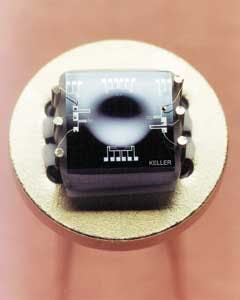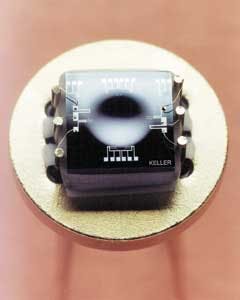The use of piezoresistive silicon as the basis for the measurement of liquid level and pressure is not a new concept, as this proven technology is the core of instrumentation from a wide variety of manufacturers for an even wider variety of industries. The future of the technology, however, relies not as much on further development of the sensor element but on advances in the compensation and signal conditioning technologies that accompany it.
Piezoresistive technology is mature and well understood. Having replaced the bonded/unbonded strain gauge and thin-film technologies decades ago, it is now the most readily mass-produced and cost-effective method of converting pressure into an electrical signal. Single-crystal silicon is etched to create a sensing diaphragm, then ion-implanted with a dopant, usually boron, to produce a four-arm Wheatstone-bridge configuration. Pressure-induced strain causes the bridge to become unbalanced, creating an output that is proportional to the pressure input.
Unfortunately, piezoresistive silicon is not immune to temperature-induced error. As temperature variations cause the material to expand/contract, the values of the bridge resistors change. This causes a change in the output that is not due to a change in pressure. Fortunately, this behavior can be corrected by what is known as temperature compensation.
Historically, the passive thermal compensation technique was employed through the addition of fixed resistors connected to the bridge in such a way as to counteract the bridge error. This technique resulted in a pressure transmitter that was capable of a Total Error Band over -10°C to +80°C of ±2% FS.
While there are some applications for which the passive technology remains sufficient, many applications now require a higher accuracy measurement under real-world conditions (i.e., over a wide temperature range). The advantages of less-expensive, high-performance microprocessor controls can only be realized through accurate feedback. Therefore, pressure transmitter manufacturers who intend to complete in today's and future markets must also embrace microprocessor technology to improve pressure transmitter performance in real-world conditions.
The accuracy class required by the application will determine which technique of microprocessor-compensation is employed. If ±0.7% FS over -10°C to +80°C is sufficient, a biasing technique can be employed, whereby the analog output is biased according to information obtained during calibration. The advantage of this technique is that high frequency response is maintained, since the analog path is uninterrupted.
Should a better class of performance be required, the polynomial technique is employed, resulting in ±0.1% FS performance over -10°C to +80°C. This level of performance was unheard of in reasonably-priced pressure transmitters only a few years ago.
In addition to performance over temperature, microprocessor technology provides other advantages as well. Among the most important are price, lead time, and capability. Production cycle times are significantly reduced, thereby lowering production costs. These savings are passed along to the user in the form of lower unit prices and reduced process downtimes. Even specialty pressure ranges and custom cable lengths can be provided with no additional production time required, enabling the integration of new technology into legacy systems.
Additional benefits of digital, microprocessor-based instruments are found in the versatility of output and connectivity options.
Some manufacturers, like Keller, offer complete lines of microprocessor-based level and pressure measurement instrumentation, some of which offer dual output functionality that will simplify connections to either analog (4-20 mA, 0-10 VDC, etc.) or digital MODBUS-based control systems.
Looking forward, continuing innovation in miniature electronics will result in further improvements in both real-world accuracy as well as production cost. Increased memory capacity will facilitate more complex calculations to improve transmitter accuracy over wider temperature ranges. Increased processing speed will improve measurement frequency and response time. And, new options for communication protocols will ensure ongoing system compatibility as connectivity requirements evolve.
Keller America is exhibiting at AWWA's ACE14 expo in Booth 838.




